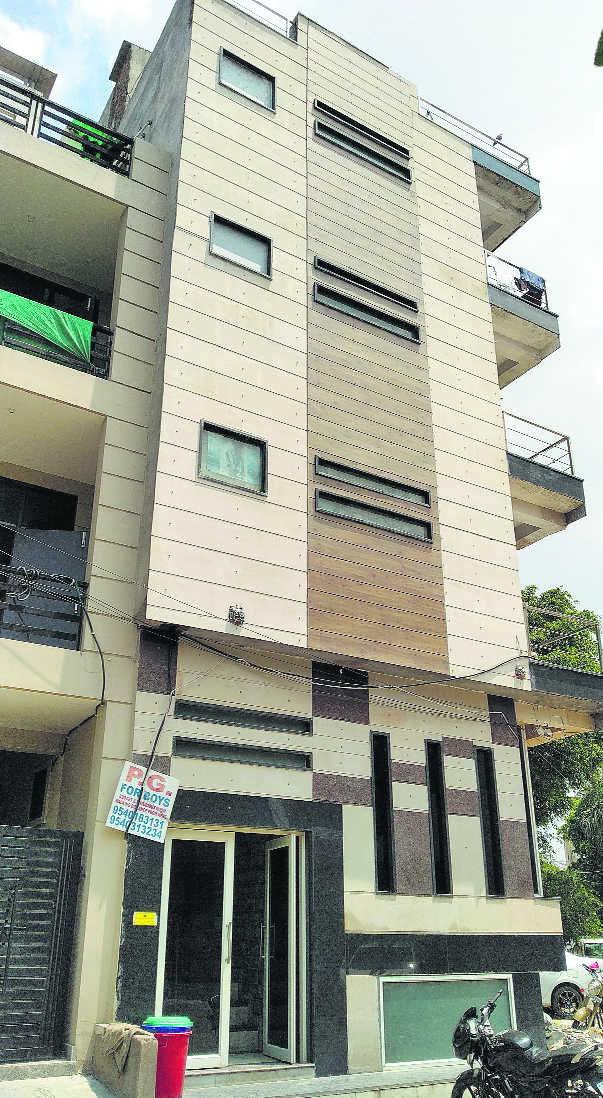Sumedha Sharma
While the state government is yet to announce the long promised residential area utilisation policy, Gurugram city continues to struggle with over 3,000 unregistered and illegal paying guest (PG) accommodation and guesthouses. What was thought to be an answer to the growing need of rental accommodation due to multi-national companies (MNCs) in Gurugram in the late nineties has become a nightmare. A labyrinth of illegal multi-storey buildings housing around 50 people each are not only burdening the civic infrastructure but also causing an estimated revenue loss of over Rs 100 crore each year. Interestingly, while these accommodation have become landmarks in all sectors or residential colonies, according to the district records, only 10-odd PG accommodation are registered with the authorities.
It all started around 2000 when the millennium city witnessed a sudden
influx of people from all over India who came to work in MNCs or call centres. The city started growing from renting attics to flats and then eventually to converting houses to girls’ and men’s hostels, as they were called then. Lured by rental income and ‘ease’ of business, soon people started establishing special accommodation in Gurugram city with a promise of food and hassle-free living.
A survey conducted by the Municipal Corporation of Gurugram (MCG) in 2013 revealed that there were over 2,000 such accommodation in the entire urban area, including HUDA sectors or colonies of the MCG or private builders. Though a lot of hue and cry was raised then, no concrete steps were taken. Today, Gurugram is the biggest PG hub in the National Capital Region (NCR), according to a recent realty survey. The advent of Metro rail services has aggravated the problem. Economically-weaker section (EWS) plots around Cyber City villages such as Jharsa, Chakkarpur, Sukhrali, Kanhai or residential areas such as DLF, Sushant Lok or Patel Nagar, Kirti Nagar, Saraswati Vihar etc, and multi-storey honeycomb type buildings are a common sight in the city. Drive through any of these areas and you will find massive construction activities going on. Houses are being pulled down to set up towering PG accommodation. Recently the MCG sealed a seven-storey accommodation in Kirti Nagar after one of the neighbours raised a hue and cry, calling it a threat to his life in case of an earthquake. He, however, was one of those whose objections were addressed.
There are numerous such complaints lying pending with the Town and Country Planning Department and the MCG. Residents have highlighted how the PG accommodation are affecting the water and electricity resources, besides posing a security threat, but to no avail.
“Residents have made numerous complaints and have even provided a list of illegal accommodation in their areas but the authorities concerned are yet to ensure law enforcement. Every time we are told that a new policy is being framed but nothing has happened so far. House owners are accommodating 50 people in an area meant for four or five tenants, thereby taxing infrastructure. We want the Haryana Government to form rules for this,” says RS Rathee, local activist and member of the Qutab Enclave Residents’ Welfare Association.
The residents claim that over the last few years illegal guesthouses had come up in the city. Almost all sectors and villages in the city have numerous guesthouses or online accommodation portal properties such as OYO rooms. The activity started soon after the government issued bed-and-breakfast licences in the wake of the 2010 Commonwealth Games. In lure of rental income, villagers of Gurugram procured licences and soon every home had a Band-B facility. Due to the indifferent attitude of HUDA and MCG enforcement officials, soon nobody cared to take a licence and illegal guesthouses came up, adding to the problems faced due to the PG accommodation.
Interestingly, while the MCG can take action against the PG accommodation under the Haryana Municipal Act 1994, and the Department of Town and Country Planning enforcement wing can seal them under the Haryana Development of Urban Areas Act 1975, not much action has been seen in the last five years. Both authorities now shift onus to address the problem on recently-constituted GMDA.
“Yes, we have a new enforcement wing but that is primarily for checking illegal colonies. The Department of Town and Country Planning is responsible for violations and encroachments in licensed areas, while the MCG is responsible for violations in unlicensed areas. We can coordinate and share force but they will have to initiate action”. V Umashankar, CEO, GMDA.
“There is no denying the fact that the PG accommodation are our biggest headache. Despite repeated attempts nobody wants to register these accommodation with the government authorities. People take permission for two-storey houses but build seven-storey paying guest accommodation. Enforcement gets stuck in jurisdiction, policies etc. We started a special enforcement drive under a policy announced for a brief period in 2016. That policy was to be amended, and it is still awaited. Though we keep a check in our area, enforcement needs to be streamlined and activated,” says Yashpal Yadav, Commissioner, MCG.
There is no denying the fact that the PG accommodation are our biggest headache. Despite repeated attempts nobody wants to register these accommodation with the government authorities. People take permission for two-storey houses but build seven-storey paying guest accommodation. Enforcement gets stuck in jurisdiction, policies etc. We started a special enforcement drive under a policy announced for a brief period in 2016. That policy was to be amended, and it is still awaited. Though we keep a check in our area, enforcement needs to be streamlined and activated —Yashpal Yadav, Commissioner of Municipal Corporation, Gurugram
.
Unlock Exclusive Insights with The Tribune Premium
Take your experience further with Premium access.
Thought-provoking Opinions, Expert Analysis, In-depth Insights and other Member Only Benefits
Already a Member? Sign In Now










